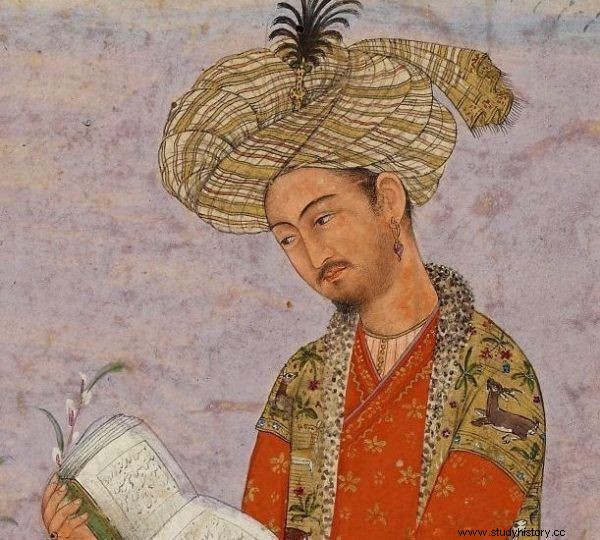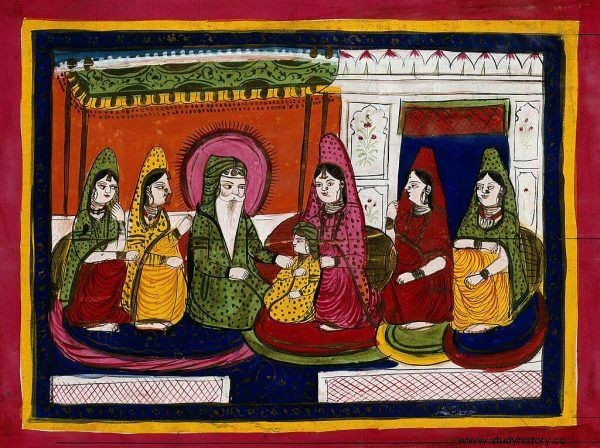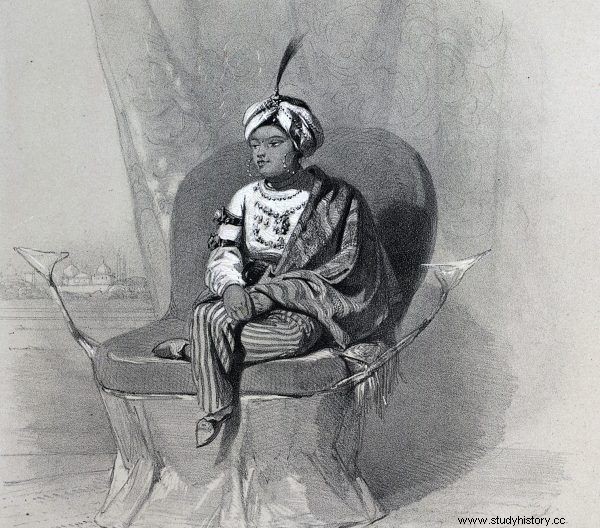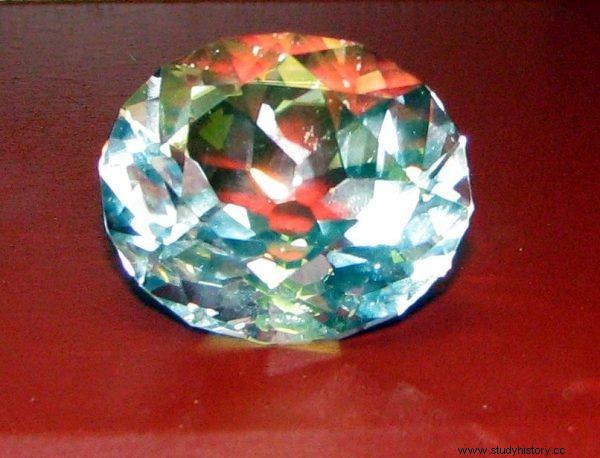A theme for endless legends, rumors and the weirdest stories. The owners of this diamond fell into madness, fell into incomprehensible diseases, were poisoned and murdered. Was it Koh-i-noor who brought them nothing but misfortune?
When it comes to the earliest history of Koh-i-noor, or "The Mountain of Light," there is a lot of wondering. The records say that the stone belonged to the Mughal ruler, Babur, who lived at the turn of the 15th and 16th centuries. In any case, he had a diamond with a weight equal to the title - on this basis, many concluded that it was Koh-i-noor.
Babur had a son, Humayun, who liked to dream more than fight and soon had to leave India after his father's death. He took with him precious stones hidden in a purse, among which there was probably also the most precious one. He presented them as a gift to Tahmasp, the Shah of Persia.
The Madness of a Persian Ruler
The new owner did not enjoy the beautiful trinket for a long time. For unknown reasons, he handed it over through a messenger to his ally from the Deccan, Nizam Shah. Unfortunately, the priceless treasure was lost on the way. Years passed before a stone weighing similar to that once possessed by Babur was returned to the hands of the Mughal Mughals.
Jahangir, the ruler of the Mughals at the time, loved valuables, as did his son, Prince Khurram, the future Emperor of Shahjahan. The latter became a true jewel expert - he even wore stone-studded glasses with diamond and emerald lenses ! Unfortunately, after his death, the dynasty ended. The rulers' love for valuables attracted the leader of the Persians, Nadir Shah Afshar, who invaded northern India in 1739.

The first owner of Koh-i-noor was most likely Babur, ruler of the Mughal Empire.
The Shah then conquered Delhi, the capital of the Mughal Empire, among others. He did this because he needed resources that would allow him to finance his own troops. About thirty thousand inhabitants of the city lost their lives in the invasion. Later, the seat of the rulers fell victim to looting. Countless riches opened up before the Persians, and valuables were counted over many days. Koh-i-noor was among the loot. It was stuck in the Peacock Throne, made at the behest of Shahjahana, a jeweled seat.
Nadir feared the stone would be stolen from him. It drove him insane at last; he was also becoming more and more cruel. In 1747 he was killed by assassins. The "mountain of light", which he and Ruby Timura had ordered to be removed from the Throne earlier and placed on his armband, was the target of the Afghan battalion of Ahmad Khan Abdali (now considered the founder of modern Afghanistan).
Diseases and poisons
Ahmad, like his predecessor, wore these two unique treasures on his shoulder. Afghanistan became home to Koh-i-noor for the next 70 years. The state grew in strength, but the ruling government deteriorated more and more. His body was literally rotting, as William Dalrymple described in Koh-i-noor. The history of the most famous diamond in the world ”:
(...) Ahmad Sah finally defeated an enemy more relentless than any army. From the beginning of his reign, his face was devoured by a disease called "gangrenous ulcer" in Afghan sources, possibly leprosy, syphilis or some form of cancer . When he was winning his greatest victory at Panipat, the disease had already deprived him of his nose, and in his place he had a "prosthesis" set with diamonds.
The ruler died in 1772, after worms started to come out of his nose and reportedly fell into his mouth and food. The power was then taken over by his son Timur Shah Durrani, who wore Koh-i-noor on his right forearm (and on his left he placed a beautiful ruby called the Eye of Hurysa). He was an outstanding military strategist, but there were many conspirators waiting for his life.
Like the previous owners of the legendary stone, he did not live to see natural death. He died in the spring of 1793 - most likely he was poisoned. He left as many as 24 sons, but did not appoint a successor. The succession struggle broke out and the country plunged into crisis. The heirs of the Shah tried to invade India again, but it was increasingly under the influence of the East India Company and were no longer such an easy opponent.
Koh-i-noor, meanwhile, was in the hands of Shah Zaman, son of Timur. When he was captured and blinded, he hid the stone in the wall of the dungeon where he was locked up. The search for the missing diamond was later undertaken by his younger brother, Szudża. It was found with a mullah who was using it as a… paperweight! Hurysa's eye was in the possession of a student who found it washing in the river .
The Last Sikh Rulers
In the meantime, Randjit Singh, the creator of the Sikh state, became interested in the legendary jewel. In 1813 he managed to get it. He received a stone in such an inconspicuous bundle that he suspected he had been deceived! He had his jewelers investigate, but they assured him that he did indeed own the "Mountain of Light".
Interestingly, the Maharaja even tried to price his treasure, but then everyone told him that he had acquired a unique, priceless item. He wore it in a turban, though he was afraid that if he overdid it, he would be robbed. Fortunately, he had a heavily guarded vault at his disposal.

Randjit Singh put the jewel in Sikh hands.
Radzit, although he drank too much, was considered a good ruler and had excellent contacts with the British. In 1838, after his second stroke, he accepted them dressed modestly, but still with the beloved jewel on his shoulder. However, when he died, for some time no one knew where the diamond was ... As it turned out, the treasurer of Beli Ram did not fulfill the ruler's last will and did not hand over the stone to the temple - he hid it in the treasury, believing that it belongs to the entire Punjab.
The successor of the Maharaja, Charak Singh, however, did not undertake the search for a beautiful trinket. He preferred to drink and play all day. He didn't even notice that he was poisoned. He died quickly, handing power over to his son, Nau Nihali Singh. This one was a natural leader, worthy of Koh-i-noor, but he had bad luck too. Soon after his father's funeral, he was fatally wounded by a boulder. His brother replaced him. "On January 18, 1841, Sher Singh with Koh-i-noor on his armband was anointed as the Maharaja of the Punjab," writes Anita Anand .
The stone also did not bring happiness to this ruler. Barely a year after the ceremony, the gun shown to him "accidentally" fired. The result of the accident was tragic, especially since the shot was fired twice. In addition, Sher Singh's 10-year-old son was literally dismembered. The last in line to the throne was only five-year-old Dalip Singh, son of Randjit. And so Koh-i-noor found himself on the child's shoulder, and the child - on the lap of her 26-year-old mother, Jindan, who was going to rule the country.
Road to Britain
Before the young Maharaja could establish himself on the throne, the British stepped in. They vowed to remain in Lahore only until the new ruler turned 16. The boy was quickly separated from the regent, and the bloody riots gave the British a reason to take over the Punjab with its greatest wealth - the "Mountain of Light". After heavy fighting, Dalip was forced to sign the act of surrender. His third point was a commitment to donate the diamond to the Queen of England.

The last owner of Koh-i-noor from the Sikh dynasty was a minor Dalip Singh.
Now it was necessary to safely transport the treasure to the Islands. It was taken care of by John Lawrence, called by the peasants "the savior of Punjab" (partly because he fought for low taxes for them). Anita Anand in the book Koh-i-noor. The history of the most famous diamond in the world ”reports:
The diamond was taken from the vault and formally placed in John's care. If his official biographer is to be believed, John seriously took the jewel from its box, put it in his vest pocket, took it home and quickly forgot the whole thing .
When clear instructions were given that it was time to bring the stone home, the man realized that he did not know where the precious thing was. An old porter helped him in his search, who, having found Koh-i-noor, reportedly said: "There is nothing here, sahib - Only this piece of glass!" .
The most difficult part of the journey was its overland stage. The treasure, transported to the port in Mumbai, was exposed to thieves. Only discretion could help here. It was not possible to inform too many people about the planned action. No wonder that the transport took nearly two months. Eventually, the stone arrived safely at the port. Now there is a suspenseful wait for a suitable ship. Another few weeks passed. As we read in the book "Koh-i-noor. The history of the most famous diamond in the world ”:
Finally, on April 6, 1850, Koh-i-noor was shipped aboard HMS Medea, a steam warship commanded by experienced Captain William Lockyer. The captain watched as a double-locked iron box was brought onto the ship. It was only when the anchor was lifted that he found out how important cargo it was carrying.
The keys to the chest were distributed so that it would take three men to open it. As it turned out, the biggest threat on board was not the thief, but the raging cholera that took its toll. The crew counted on the support of the people of Mauritius, where they wanted to stop along the way, but the terrified island authorities threatened to shoot the ship's passengers if they disembarked. They were only given the coal they needed to keep going.
It was not the end of the chilling adventures of sailors. Shortly thereafter, Medea was threatened by a great storm. It was as if there was really a curse over the Mountain of Light. Moreover, just as the ship was entering British territorial waters, Queen Victoria was attacked! The attacker, using a black cane with an iron handle, hurt her painfully. The monarch wore the scar of this event for years .
Last stop?
The headlines screamed about Koh-i-noor and the unjustified assault at the same time. Does a precious object bring bad luck to women as well? In addition, the Queen received the stone on July 2, 1850, on the very same day that her confidant and friend Sir Robert Peel died in a tragic accident.
When the stone landed in British hands, it looked completely different than it does today. It weighed 190.03 carats and had the so-called Mongolian cut. Not only was it the greatest booty ever brought from India, it was also a symbol of Victorian Britain's ultimate domination of the world. He was like a trophy to brag to show off your strength!

Koh-i-noor gained audience interest only after it was polished. The photo shows a copy of the diamond (new cut).
Queen Victoria, immediately after receiving the stone, made it available to the curious eyes at the Great Exhibition. It was opened on May 1, 1851 in the Crystal Palace, built especially for this occasion. Of course, it was not possible to put such a treasure in an ordinary museum display case - special security was used.
Unfortunately, the room where it was presented was extremely hot, and the stone (even when illuminated) was not particularly liked by the audience. Only after grinding it gained a new shine, at the same time decreasing from 190.3 to 93 carats. Only then did the enthusiasm of the subjects arouse, and Koh-i-noor became so beautiful that he could become the main ornament of the British crown.
Bibliography:
- Anita Anand, William Dalrymple, Koh-i-noor. The history of the most famous diamond in the world , Noir Sur Blanc 2019.
- Ian Balfour, Famous Diamonds , Antique Collectors Club Dist. 2008.
- Edwin Streeter, The Great Diamonds of the World. Their History and Romance , Forgotten Books 2018.
